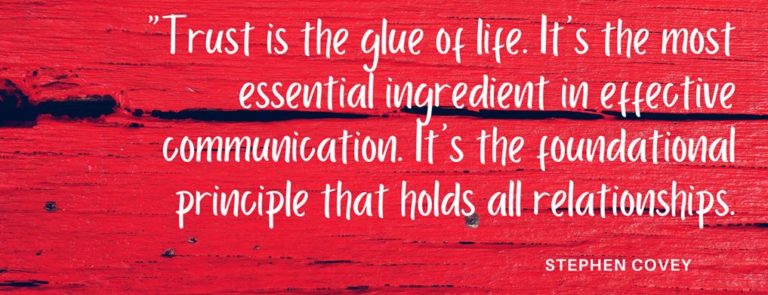
Whether we intentionally begin our coaching conversations on the topic or not, somehow this topic always takes centre stage: TRUST.
Most of my clients acting in a leadership capacity are focused on excelling in leading and keeping their people motivated and engaged with the vision they seek to achieve. Initial conversations may be focused around leadership styles, brand, behaviours and qualities of great leaders. But when it comes to leadership effectiveness, what it all comes down to – first and foremost – is trust.
Leadership is all about trust. The first job of any leader is to inspire trust. It is trust that transforms a group of people into a team. All of the duties a leader performs begin and end with trust. With trust, a leader can align individuals into a high-performing team capable of achieving the organization’s mission and vision.

The leader who does not establish trust will have no followers. Trust is the primary attribute associated with leadership, and trust that is broken can have a negative effect on a group’s performance. People are unlikely to follow someone they think is dishonest, or someone they think will take advantage of them. Without trust, a leader will fail to inspire a productive team culture.
In a leadership context, trust means that employees expect their leaders to treat them well. The upside of this is that employees will feel comfortable being open with their leaders.
When your team trusts you as a leader, it increases commitment to team goals. Communication improves, and ideas flow more freely, increasing creativity, productivity, wellbeing in the workplace and corporate culture. Perhaps most important, in the hands of a trusted leader, employees are more comfortable with change and more willing to embrace a new vision.

HOW DO LEADERS BUILD TRUST?
To be effective, leaders need their team’s trust. Leaders build trust and collaboration by focusing on developing their people’s capabilities, rather than focusing on their limitations.
Inspiring trust in others is essential in motivating and inspiring team members. But building trust is no simple task. So how do the best leaders gain their people’s trust, so they can empower them to reach new heights?
To get that trust – or to get it back if you’ve lost it – leaders can do so by applying the following:
1.Practice what you preach. What you think, say and do reveals how authentic you are as a leader. To be a trustworthy leader, you must first and foremost show up as your authentic self.
Trustworthy leaders are genuine people. They reinforce their values by demonstrating their commitment to them through their work and actions. Be aware of what message you’re communicating through not only your words, but also your actions.
No one can trust a leader they believe is dishonest or insincere. Avoid hiding your beliefs or behave differently in order to exercise your authority, and especially don’t hold yourself to a different standard than you hold your people.
Trustworthy leaders create a safe work environment where all individuals are not only appreciated for being their true selves, but for being the company’s biggest asset.
2.Care deeply about your people. The most successful leaders build relationships with their people each and every day, placing this activity even ahead of business. They place people first – even at times of crisis – and they are aware that profits cannot be made without people.
To gain trust, you have to care about building trust, which means you have to care about the people whose trust you must earn. You only have to take a look at how different companies responded to the current pandemic to identify which leaders command their people’s trust and are helping them not only survive the hard times, but bounce back better and stronger than before. Because when people can trust that you have their back as the leader, they are willing to go that much farther to ensure that the organization thrives.
3.Welcome feedback, and act on it. The reality is that all leaders make mistakes. Without feedback, we simply cannot improve, and so leaders must be open and encourage constructive feedback, just as they need to be willing to give feedback to others.
Leaders must also be willing to act on it and demonstrate their willingness to improve. This in no way makes you weak or undermines your power, quite the opposite in fact. These are the kind of leaders that people are inspired to follow.

4.Create a safe workplace. Help others express themselves, their ideas, and vent their frustrations. Help employees achieve their goals. Give your employees room to grow their skills and self-esteem by offering them training and coaching.
5.Give trust to receive trust. Give your employees the necessary authority to accomplish their assignments and trust their decisions. Admit mistakes, acknowledge negative situations and sincerely apologize if necessary. Take responsibility for your actions.
However, beware of people who will take advantage of your eagerness to trust. Learn how to detect these toxic individuals and protect yourself from them.
6.Don’t allow communication to break down. Don’t withhold any information from your team. Misunderstandings are easily created and can decrease trust. Be open and honest with important company information. Don’t shy away from the truth. Actively listen to your team without speaking or emitting judgements, and involve your team in the decision-making process.
You can’t lead effectively without trust. Help your employees go above and beyond. Don’t just spend time and money trying to fix broken trust. Instead, take the time upfront to develop trusted relationships between you and your people. The more you take care of your employees, the better the company’s performance across all levels. With trust, you’ll inspire the best in your people and gain the support needed to succeed.
To your success,
Isabel



